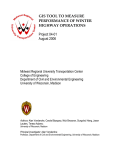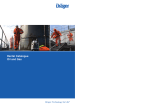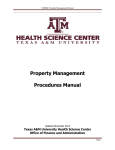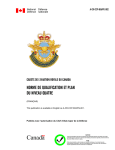Download National Collaboration Framework User Guide
Transcript
UPDATED REVIEW VERSION User Guide 7 July 2014 National Collaboration Framework: Collaborative Head Agreement Project Agreements ME_90622303_1 (W2003x) User Guide National Collaboration Framework Part 1 – Introduction and general principles 3 1. Purpose of this guide 3 2. Purpose of the CHA and Project Agreement 3 2.1 2.2 2.3 Background – the NCF Purpose of a CHA Purpose of the Project Agreement 3 3 3 3. Key principles 4 3.1 3.2 3.3 3.4 3.5 3.6 3.7 3.8 3.9 3.10 3.11 3.12 3.13 3.14 3.15 Term of a CHA and Project Agreement Legal enforceability Binding other agencies Pre-Project obligations Adding new parties Appropriateness of legislative requirements Governance of a CHA Governance of a Project Risk management Project change control Complaint and query handling Withdrawal, discharge, termination and expiry Data management Privacy Security 4 4 5 5 5 5 5 6 6 7 7 7 7 8 8 Part 2 - Guidance on the CHA and Project Agreements 9 4. Structure 9 4.1 4.2 4.3 General Project Agreement inclusions Inconsistencies 9 9 9 5. Completing a CHA 10 5.1 5.2 General Checklist 10 10 6. Completing a Project Agreement 11 6.1 6.2 6.3 6.4 6.5 6.6 6.7 6.8 6.9 6.10 Introduction Checklist for completion of a Project Agreement Intellectual property rights Risk and issues management Acceptance testing Performance management Contributions GST Branding Project implementation review 11 11 12 13 13 13 14 14 14 14 User Guide | National Collaboration Framework Updated Review Version | 23 March 2011 ME_90622303_1 (W2003x) page 2 Part 1 – Introduction and general principles 1. Purpose of this guide This User Guide accompanies the Collaborative Head Agreement (CHA) and Project Agreement prepared for the National Collaboration Framework (NCF) project. This User Guide provides an explanation of the CHA and Project Agreement, their structure and key principles. Guidance on their completion is also provided. Parties to the CHA are referred to as a Party or Parties and parties to a Project Agreement are referred to as a Project Party or Project Parties. 2. Purpose of the CHA and Project Agreement 2.1 Background – the NCF In March 2002, the Online and Communications Council set as a priority the better integration of service delivery across all jurisdictions of government. The overall aim was to relieve customers of the need to understand what element of an overall service is delivered by which agency and to improve the overall effectiveness and efficiency of government. The National Collaboration Framework (NCF) was created to assist government agencies to work collaboratively to provide the processes and tools that will increase the ability of agencies to deliver improved services to customers. The Cross Jurisdictional Chief Information Officer Committee (CJCIOC) agreed that the NCF needed to be reviewed and simplified to improve its usability for government agencies. The end result is a simplified NCF that includes a five tiered approach for Government agencies to follow when seeking to collaborate. Tier 1 involves establishing overarching Principles to collaborate that identify vision, value, scope, cost, benefits and security that guide the integration of services. Tier 2 involves agreement on statements about how organisations plan to do business together. Tier 3 is a Collaborative Head Agreement (CHA) representing commitment to those elements that apply to multiple projects across a jurisdiction/s. Tier 4 involves parties creating project specific agreements. Tier 5 provides templates, checklists, guidelines etc. specific to collaborative service delivery. 2.2 Purpose of a CHA The CHA is an overarching agreement to facilitate collaboration between government agencies for the provision of services across jurisdictions and, separately, within the Australian Government jurisdiction. The clauses of the CHA are deliberately high-level and the documents are based on the Statements of Intent and are non-adversarial in nature. A CHA is intended to establish the governance framework for a Project or Projects undertaken by two or more parties to a CHA. 2.3 Purpose of the Project Agreement While it is the CHA that sets out the framework for governance of a Project or Projects, it is the Project Agreement that sets out the requirements for a Project. Specifically, the Project Agreement deals with the development, implementation and ongoing management of a Project. The specific requirements in the Project Agreement could include (amongst other things) services, contributions, additional requirements for confidentiality and security, warranties, indemnities, liabilities and service levels, if these are applicable to a particular Project. User Guide | National Collaboration Framework Updated Review Version | 23 March 2011 ME_90622303_1 (W2003x) page 3 3. Key principles 3.1 Term of a CHA and Project Agreement The CHA and Project Agreement will operate for an initial term unless they are terminated in accordance with clause 24.4 of the CHA. The length of the initial term can be specified in Schedule 1 of the CHA and Schedule 1 of the Project Agreement. An option to extend the CHA or Project Agreement by unanimous agreement for a further specified period can be included. The Parties are required to conduct a review of the CHA and any Project Agreement at least three months prior to the expiry of the initial term. The purpose of the review is to determine whether to extend the initial term of the agreements, as well as to evaluate their effectiveness and consider whether any change is needed. The Parties can specify any particular requirements for the conduct of the review in Schedule 1 of the CHA. 3.2 Legal enforceability As a default position, the CHA and Project Agreements are not intended to create legally binding contractual arrangements between the Parties or Project Parties (see clause 9 of the CHA). If the Parties wish to make the CHA and/or Project Agreement legally binding, we recommend they seek legal assistance. If a CHA or Project Agreement is to be legally binding, the Acknowledgement of Accession in Schedule 3 of the CHA and Schedule 8 of the Project Agreement may need to be amended. A CHA and any accompanying Project Agreement can not be legally binding between agencies which do not have a separate legal status from each other. Some examples include: (a) an Australian Government Department and another Australian Government Department; or (b) a State/Territory Department and another Department of the same State/Territory. However, if the Parties or Project Parties are separate legal entities (for example, a Commonwealth Department and a State/Territory Department or a Commonwealth Department and a Commonwealth Authority established under the Commonwealth Authorities and Companies Act 1997 (Cth)), they may elect to make the CHA and/or Project Agreement legally binding. Similarly, it is also open to the Parties or Project Parties (if they are separate legal entities) to agree that certain clauses of the CHA or Project Agreement are legally binding, for example, clauses dealing with intellectual property. Parties and Project Parties should decide early in the negotiation process as to whether the CHA and any resultant Project Agreement will be legally binding as it will affect the risk profile for each party. For example, if the agreement is not to be legally binding, a party may assess the liability and indemnity clauses to present a lower risk. Where the parties are separate legal entities, whether a CHA and Project Agreement should be legally enforceable is a matter for the parties, considering issues such as the: (a) likelihood of enforcing obligations against the other parties through litigation; (b) damage that is likely to be suffered in the case of a breach of any obligation; and (c) significance of an obligation to a party and whether a legally enforceable status would emphasise the importance of that obligation between the parties. User Guide | National Collaboration Framework Updated Review Version | 23 March 2011 ME_90622303_1 (W2003x) page 4 3.3 Binding other agencies A CHA is intended to operate as an agreement between the agencies who are party to it. A CHA is not intended to be executed or operate as a whole-of-government agreement. 3.4 Pre-Project obligations Clause 13 of the CHA provides that Project Parties must complete specific obligations before commencing a Project. Project Parties must prepare a business case (clause 13.2 of the CHA) and identify any special requirements that are required to reflect the needs of a Project (clause 13.3 of the CHA). In addition to the obligations in clause 13 of the CHA, clause 10 of the Project Agreement provides that Project Parties are required to consult Stakeholders (an entity which has an interest in a particular government service) during the design, development and post implementation of the Project. 3.5 Adding new parties New parties can be added to an existing CHA by following the procedures set out in clause 8 of the CHA. The steps for admitting a new party to a CHA are as follows: (a) Step 1: the Management Committee must unanimously resolve to admit the new party. The new party will be admitted on the terms determined by the Management Committee; and (b) Step 2: the new party will be required to sign an Acknowledgement of Accession (an acknowledgement in the form of Schedule 3 to the CHA or in another form agreed by the relevant parties). In the Acknowledgement of Accession, the new party acknowledges receipt of a copy of the CHA and confirms that it will observe and perform the terms of the CHA. New parties can also be added to an existing Project Agreement by following the procedures set out in clause 5 of a Project Agreement. The steps for admitting a new party to a Project Agreement are the same as those for admitting a new party to a CHA, except that the Steering Committee must unanimously resolve to admit the new party (rather than the Management Committee). The Acknowledgement of Accession is set out in Schedule 8 to the Project Agreement. 3.6 Appropriateness of legislative requirements The CHA and Project Agreement is drafted in a jurisdiction-neutral way. This means that parties are required, in many cases, to comply with the law applicable to their separate jurisdictions rather than the law of a specific jurisdiction. For example, clause 18 of the CHA provides that 'each Party agrees to comply with the FOI Law applicable in its jurisdiction.' Similarly, clause 16.2(a)(iii) of the Project Agreement deals with the powers of the Australian Government Freedom of Information Commissioner, Australian Information Commissioner and the Australian Government Privacy Commissioner, and refers to 'the person or persons responsible for administering State or Territory laws or policies in respect of freedom of information, information and privacy'. 3.7 Governance of a CHA The CHA provides for governance and strategic management of the agreement by a representative body known as the Management Committee (see clause 12 and Schedule 2 of the CHA). The role of the Management Committee includes: (a) identifying and responding to issues raised by parties that may impact on the CHA and identifying and implementing proposed solutions; User Guide | National Collaboration Framework Updated Review Version | 23 March 2011 ME_90622303_1 (W2003x) page 5 (b) admitting new parties to a CHA; (c) undertaking the management of the CHA in accordance with relevant Australian National Audit Office principles and Australian Standards; and (d) implementing Statements of Intent, Project Agreements and the Collaboration Resource Kit. Each Party is entitled to appoint a representative to represent its interests on the Management Committee (clause 12.3(a)(i) of the CHA). The Parties to a CHA will be bound by unanimous decisions of the Management Committee (clause 12.4(b) of the CHA). Governance of the CHA is an important aspect of the commitment to collaborate in accordance with the National Collaboration Framework. As such, Parties should give careful consideration to setting up and selecting representatives for the Management Committee. 3.8 Governance of a Project Management of each Project is undertaken by a Steering Committee comprised of representatives appointed by the Project Parties (clause 15.1(a) of the CHA). A Project Party may appoint up to two representatives to represent its interests on the Steering Committee (clause 15.1(a) of the Project Agreement). The Management Committee may also, at its option, nominate a representative from the Management Committee to sit on a Steering Committee (clause 15.1(b) of the CHA). The role of the Steering Committee includes: 3.9 (a) identifying and administering policies and procedures for specific issues, including technical standards for information transfer / access, Data ownership, Data quality and protection of Data; (b) negotiating and tracking any Contributions between Project Parties; (c) managing changes to the Project or Project Agreement; and (d) reporting to the Management Committee (see clause 15.3 of the Project Agreement). Risk management Since the CHA and Project Agreements are not intended for legally binding arrangements and parties to them are most likely to deal with differences through avenues other than litigation, issues of insurance, indemnities and warranties are not material. As a result, a flexible approach to risk management is adopted under the CHA, based on the principle that risks should lie with the party best placed to manage those risks. For example, both Parties and Project Parties are required to apply and comply with AS/NZS ISO 31000:2009, Risk Management – Principles and guidelines (or any successor standard) in carrying out their obligations (clause 23 of the CHA and clause 8.1(a) of the Project Agreement). Additionally, Project Parties: (a) are required to develop a Risk Management Plan for each Project (clause 8.1(b) of the Project Agreement) and manage issues in accordance with the plan (clause 8.1(c) of the Project Agreement); and (b) agree that any liability owed to a third party arising from a Project Agreement will be governed by arrangements specified in the Risk Management Plan (clause 8.2 of the Project Agreement). If a particular Project requires specific clauses dealing with the allocation of risk, these can be agreed by the Project Parties and included in a Project Agreement. User Guide | National Collaboration Framework Updated Review Version | 23 March 2011 ME_90622303_1 (W2003x) page 6 3.10 Project change control Clause 9 of the Project Agreement sets out the procedure for changing the nature and scope of a Project or requirements in the Project Details (Schedule 1). The purpose of the clause is to ensure appropriate control by the Project Parties in relation to the scope of the Project. A transparent change control process reduces the risk of confusion about the scope of the Project and the risk of non-compliance. A change may be proposed by giving notice in the form of a Change Order (clause 9.2 of the Project Agreement) and the Change Order takes effect following agreement in writing by all of the Project Parties (clause 9.4 of the Project Agreement). A Project Party will not be required to comply with any changes to the Project unless the changes are agreed in accordance with the procedure in clause 9 of the Project Agreement. 3.11 Complaint and query handling Clause 13 of the Project Agreement sets out the complaint and query handling requirements. The clause is directed to achieving a Customer-centric approach to the delivery of government services and eliminating the inconsistencies among Project Parties and jurisdictions in handling complaints. 3.12 Withdrawal, discharge, termination and expiry The process for withdrawal and discharge from and termination and expiry of a CHA or Project Agreement is set out in clause 24 of the CHA and is summarised below: CHA Project Agreement Withdrawal 12 months' notice in writing. 6 months' notice in writing. Discharge (of a party by the other parties) By following the problem resolution process in clause 25. By the direction of all Project Parties (other than the Party to be discharged) provided 'Due Cause' has arisen. Termination With unanimous agreement of all parties. With unanimous agreement of all parties. Expiry The end of the Initial Term as specified in item B of Schedule 1 (unless the parties exercise an option to extend the Term. In that case, the CHA will expire at the end of the extended Term). The end of the Initial Project Term as specified in item B of Schedule 1 (unless the parties exercise an option to extend the Term. In that case, the Project Agreement will expire at the end of the extended Term). 3.13 Data management Clause 19 of the CHA sets out a number of requirements for access to and custodianship of Data. The purpose of the clause is to ensure proper processes are in place for accessing Data relating to Customers and to streamline data management processes to reduce the costs by Parties. Clause 19.4 deals with Data custodianship and distinguishes between the roles of a Business Custodian and Physical Custodian. A Business Custodian is the person(s) responsible for ensuring that standards, planning, processes and quality assurance are in place to support accurate delivery and use of the Data. A Physical Custodian collects, uses, stores and maintains the Data on behalf of a Business Custodian. Therefore, although the Business Custodian is responsible for User Guide | National Collaboration Framework Updated Review Version | 23 March 2011 ME_90622303_1 (W2003x) page 7 ensuring that Data is held and released consistently with legislative and policy requirements, it is the Physical Custodian that is responsible for the physical preservation of the Data. 3.14 Privacy Clause 20 of the CHA deals with general privacy requirements and Customer Consents to disclose Personal Information. The clause requires Parties to maintain the privacy of Personal Information provided to them according to the requirements of the Party providing the Personal Information. This means that if the Party providing Personal Information is a Commonwealth Agency, the receiving Party will need to maintain the privacy of that Personal Information in accordance with the requirements in the Privacy Act 1988 (Cth). Parties can specify particular requirements for the protection of Personal Information to reflect the needs of a Project in Schedule 3 of the Project Agreement. For example, if the Project involves the collection, use or disclosure of Personal Information, the parties should prepare a Privacy Impact Statement. A Privacy Impact Assessment is an assessment tool that describes the personal information flows in a project and analyses the possible privacy impacts that those flows and the project as a whole, may have on the privacy of individuals. The Privacy Impact Assessment Guide published by the Office of the Australian Information Commissioner can be accessed at http://www.oaic.gov.au/images/documents/privacy/privacy-resources/privacy-guides/guide-toundertaking-pias.pdf. Clause 20.2 of the CHA provides that parties must not disclose Personal Information about a Customer unless the Customer has expressly (and not implicitly) consented to the disclosure. However, the parties can agree on circumstances where Consent which is not in writing will be permitted and specify them in Schedule 3 to a Project Agreement. In doing so, the parties will need to have regard to the relevant privacy legislation. 3.15 Security Clause 22 of the CHA requires parties to keep Data secure in accordance with minimum standards to ensure that the integrity of Data is not compromised. Parties can specify additional security requirements to reflect the needs of a Project in Schedule 3 of the Project Agreement. Parties should also consider including a requirement that they must comply with the Australian Government's e-Security National Agenda (ESNA), the Australian Government Protective Security Policy Framework and the Australian Government Information Security Manual formerly ACSI 33. User Guide | National Collaboration Framework Updated Review Version | 23 March 2011 ME_90622303_1 (W2003x) page 8 Part 2 - Guidance on the CHA and Project Agreements 4. Structure 4.1 General The CHA includes high-level provisions for the governance of a Project or Projects. The governance and strategic management of a CHA is undertaken by the Management Committee constituted by representatives of the parties (see further section 3.7 above). A Project Agreement, in contrast with a CHA, is designed to include specific Project-related provisions. The template Project Agreement (which is a separate document to the CHA), has been designed to be used for multiple projects under the one CHA. A separate Project Agreement should be completed for each Project using the Project Agreement. The following diagram shows how an entity can be a party to a Project Agreement without being a party to the related CHA (clause 2.1(b) of a Project Agreement). Conversely, an entity can be a party to a CHA without being a party to a Project Agreement. Completion of a Project Agreement is dealt with in more detail in section 6 below. Collaborative Head Agreement Parties: Agency A, Agency B, Agency C 4.2 Project Agreement 1 Project Agreement 2 Project Agreement 3 Project Agreement 4 Parties: Agency A Agency B Parties: Agency A Agency C Parties: Agency B Agency C Parties: Agency A Agency B Agency C Project Agreement inclusions A Project Agreement consists of clauses 1 to 17 and the Schedules of the Project Agreement (which includes the Project Details and the Statement of Work) and clauses 1 to 26 of the CHA (with the exception of clauses 5 (Duration of CHA) and 12 (Governance of CHA)). For each Project, the parties will need to negotiate the specific requirements that are to govern the Project and complete the Project Agreement to include those requirements. Each Project is managed by a Steering Committee (see further section 3.8 above). 4.3 Inconsistencies It is possible that a CHA and a Project Agreement could be inconsistent. Such inconsistency is dealt with under clause 6.2 of the CHA and clause 2.3 of the Project Agreement. The clauses provide that in the event of inconsistency between the CHA and any Project Agreement, the Project Agreement will take priority to the extent of the inconsistency. Further, in the event of User Guide | National Collaboration Framework Updated Review Version | 23 March 2011 ME_90622303_1 (W2003x) page 9 inconsistency between clauses 1 to 17 of the Project Agreement and any Schedule to the Project Agreement, the Schedules will prevail to the extent of the inconsistency. The clauses have been drafted in this way to ensure that parties to a Project Agreement have the flexibility to negotiate particular requirements for a Project that will not be overridden by the terms and conditions in a CHA. Therefore, parties will need to be aware when they are negotiating the Statement of Work (Schedule 2) and Specific Requirements (Schedule 3) in the Project Agreement, that any agreement reached which is reflected in the Schedules will override the executed CHA to the extent of any inconsistency. 5. Completing a CHA 5.1 General In preparing a CHA, the parties will need to consider the provisions of the CHA and whether they meet the requirements of the Parties. 5.2 Checklist In addition to finalising the terms of the CHA, Parties should complete the following steps: Item CHA reference Action 1 Front page Insert the names of the Parties. 2 Details page Insert the date the last party signed the CHA. Insert the names of the Parties. 3 Schedule 1 (CHA Details) Complete item 1 by inserting the Parties' details (ie, ABN, address for Notices) Complete item 2 by inserting the following information: A the date the CHA is to commence; B the Initial Term for which the CHA is to continue; C any requirements for review of the CHA prior to the expiry of the Initial Term; D any applicable Option Periods; and E the law which is to govern the CHA. Although in the majority of cases the CHA and/or Project Agreement will not be legally binding, Parties should still give some consideration to the governing law which is to apply to the agreements, as it may have some impact on the obligations of the Parties (eg, stamp duty requirements). 4 Schedule 2 (Conduct of Management Committee) Insert information where indicated (eg, insert the names and contact details for each member of the Management Committee). Amend the role of the Management Committee as applicable in item 1.3. 5 Schedule 4 (Confidential Information) Insert any information which is designated by the Parties as Confidential Information (eg, details of contributions, if this is sensitive to a party). User Guide | National Collaboration Framework Updated Review Version | 23 March 2011 ME_90622303_1 (W2003x) page 10 6 Signing page Insert the names of the Parties as indicated. If there are more than two parties, the execution block will need to be copied and inserted. 7 CHA Arrange for each Party's authorised representative to execute the CHA. 6. Completing a Project Agreement 6.1 Introduction The process for completing a Project Agreement is more detailed than for completing a CHA. As explained in section 4.2 above, a Project Agreement consists of: (a) the clauses of the Project Agreement and the Schedules; and (b) the clauses of the CHA (except clauses 5 and 12). For each Project, the parties will need to negotiate the specific requirements that are to govern the Project and complete the Project Agreement to include those requirements. A separate CHA does not need to be executed for each Project. Some key considerations in preparing a Project Agreement are set out below. 6.2 Checklist for completion of a Project Agreement In addition to finalising the terms of a Project Agreement, the Project Parties should complete the following steps: Item Project Agreement reference Action 1 Front page Insert the names of the Project Parties. 2 Details page Insert the date the last Project Party signed the Project Agreement. Insert the names of the Project Parties. Insert the date some or all of the Project Parties signed the CHA and a brief description of the CHA objective. 3 Schedule 1 (Project Details) Complete item 1 by inserting the Project Parties' details (ie, ABN, address for Notices). Complete item 2 by inserting the following information: User Guide | National Collaboration Framework Updated Review Version | 23 March 2011 ME_90622303_1 (W2003x) A the date the Project Agreement is to commence; B the Initial Term for which the Project Agreement is to continue; C any applicable Option Periods; and D the name of the Project Manager. page 11 4 Schedule 2 (Statement of Work) Insert information where indicated (eg, overview of Project, objectives of Project, services to be provided as part of the Project, roles and responsibilities of each Project Party, risk and issues management and acceptance testing). Note: If an item in the Statement of Work is not applicable to the particular Project, users can mark it as 'not applicable'. 5 Schedule 3 (Specific Requirements) Insert information where indicated (eg, additional terms and conditions, Project governance, monitoring and reporting requirements, training requirements, privacy requirements and security requirements). Note: If an item in the Statement of Work is not applicable to the particular Project, users can mark it as 'not applicable'. 6.3 6 Schedule 4 (Project Steering Committee) Insert frequency of meetings and any additional services to be undertaken by the Project Manager. 7 Schedule 5 (Performance Management) Insert any applicable Service Levels and details of how the Service Levels will be measured and reported against. 8 Schedule 6 (Risk Management Plan) Project Parties need to prepare a Risk Management Plan substantively in the form of Schedule 6. 9 Schedule 7 (Contributions) Insert information where indicated (eg, introduction and overview of the Project Parties' general approach to Contributions, details of any funding and a description of any other Contributions). 10 Schedule 9 (Confidential Information) Insert any information which is designated by the Project Parties as Confidential Information (eg, details of contributions, if this is sensitive). 11 Signing page Insert the names of the Project Parties as indicated. 12 Project Agreement Arrange for each Project Party's authorised representative to execute the Project Agreement. If there are more than 2 parties to a Project Agreement, the execution block will need to be copied and inserted. Intellectual property rights The Project Parties can specify requirements relating to intellectual property rights in item 8 of Schedule 3. The Project Parties should consider the full range of options for ownership of Intellectual Property Rights created under a Project Agreement. Broadly, the options for a Project Party are either ownership of material created under a Project Agreement or a licence to the material but not ownership. In determining what position to adopt, Project Parties should consider: (a) the material that is likely to be created under the Project Agreement; (b) their requirements for the material during the term of the Project Agreement (eg, does the Project Party need to reproduce or modify the material or use it outside of Australia?); and User Guide | National Collaboration Framework Updated Review Version | 23 March 2011 ME_90622303_1 (W2003x) page 12 (c) their requirements for the material after expiration, termination, withdrawal or discharge from the Project Agreement. If a Project Party requires a licence (but not ownership) to material created under a Project Agreement, that Project Party will need to carefully consider the terms of the licence to ensure they are sufficient to enable it to deal with the Intellectual Property Rights in the manner required. Parties are encouraged to follow, if applicable, any whole of government approaches to intellectual property licensing. Parties are also encouraged to seek advice from their legal advisers before deciding on appropriate Intellectual Property Rights provisions. 6.4 Risk and issues management Parties can insert details of how they will manage risk and issues that arise during the term of the Project Agreement in item 11 of Schedule 2 (Statement of Work). For example, the Parties may agree to implement and maintain an issues database to record and manage Project issues. Alternatively, more specific details could be inserted, for example, by specifying an escalation procedure for issues. 6.5 Acceptance testing Details of any acceptance testing process the services must undergo before they are accepted by a Project Party or Project Parties should be specified in item 13 of Schedule 2 (Statement of Work). Acceptance testing is conducted in order to demonstrate whether the services performed under the Project Agreement meet a certain required standard. Whether or not acceptance testing should be required under a Project Agreement will depend on the importance and complexity of the services. Project Parties should insert their requirements for acceptance testing in the Statement of Work including, for example, the: 6.6 (a) Project Party responsible for conducting the acceptance tests; (b) standard the services are required to meet (ie, the acceptance criteria); (c) time frames for acceptance testing; and (d) action required if the services fail acceptance testing (eg, rectification of the problem within a specified period of time). Performance management The Project Parties' requirements for performance management should be inserted in Schedule 5. In particular, any service levels required to be met and the measurement and reporting mechanisms Project Parties are required to effect and maintain should be inserted. Service levels are the standards of service a Project Party or Project Parties are required to meet and could include, for example, requiring a Project Party to ensure a designated telephone service is available from 8am to 5pm on business days. Measurement and reporting mechanisms assist the Project Parties in monitoring the performance of the services and the extent to which they are meeting the service levels (if any). Specific measurement and reporting mechanisms, if applicable, should also be inserted in Schedule 5. These could include, for example, achievement against milestones and the production of reports on a monthly basis which details problem response and resolution times. User Guide | National Collaboration Framework Updated Review Version | 23 March 2011 ME_90622303_1 (W2003x) page 13 It is advisable to identify the particular measurement and reporting requirements in specific terms in the Project Agreement. However, if that is not possible because of the nature of the Project, it may be appropriate to provide that measurement and reporting mechanisms will be determined by the Project Parties during an initial stage of the Project. 6.7 Contributions The Project Parties will need to consider the Contributions they will make to the Project. Contributions can be cash financial inputs or in-kind contributions, such as personnel, facilities or equipment. Specifically, Schedule 7 of a Project Agreement should include details of the: 6.8 (a) timing of the Contributions and the form in which they will be made (for example, the provision of facilities, personnel, data, IT systems or funding); and (b) the Project Parties' positions in relation to costs. For example, if the Project Parties are to meet their own costs in connection with the performance of their obligations under the Project Agreement, this will need to be specified in Schedule 7. GST Clause 7.3 of the Project Agreement deals with GST applicable to Project Contributions. The clause has been drafted broadly and is not intended to cover specific GST issues that may arise between Project Parties. Therefore, we recommend that Project Parties seek specific GST advice in relation to each Project Agreement (both in terms of the GST implications of the arrangement and the efficacy of the GST clause for that project). 6.9 Branding Clause 16 of the CHA provides that the focus of branding will be on the service being provided to the Customers rather than individual Parties. The purpose of the clause is to ensure that branding focuses on the Customer (rather than individual agencies) and emphasises the collaborative nature of the services. Project Parties can insert specific branding requirements for a Project in Schedule 3 to a Project Agreement. 6.10 Project implementation review Project Parties are required to insert a description of any review processes to be carried out following implementation of a Project in item 14 of Schedule 2. Such processes give Project Parties an opportunity to review the implementation of the Project before commencing ongoing management of the integrated service. Examples of review processes Project Parties may want to consider include target outcomes, performance against Service Levels and transition. User Guide | National Collaboration Framework Updated Review Version | 23 March 2011 ME_90622303_1 (W2003x) page 14
























